An interview with TOBIAS KASPAR
by Carter Mull and Laura Dennis
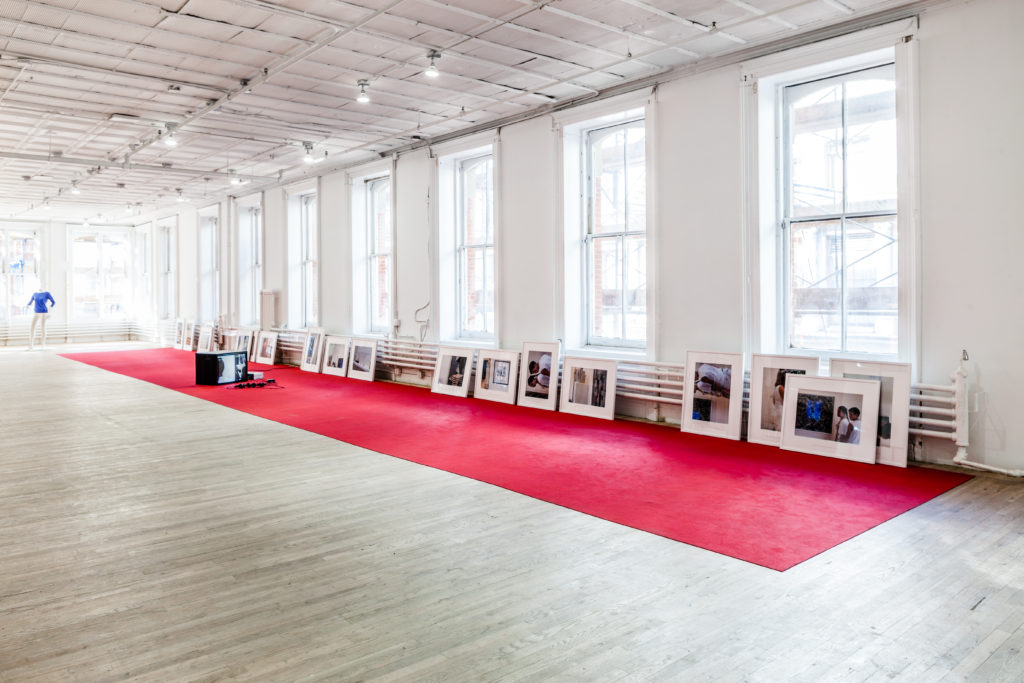
Following a stint in the Spring of 2014 when artist Tobias Kaspar and I shared the Kunst Halle Sankt Gallen space with simultaneous, overlapping shows, I have remained attentive to our similarities and differences as artists. As much as it would be a pleasure to illuminate such projects of his as PROVENCE (2009– present), in classic Kaspar fashion, where social performance, fiction, and discourse weave together, a collaborator of mine, Laura Dennis, and I sat down to see if it could be possible to get at salient aspects of his practice. Following Kaspar’s large-scale project, Independence (2018), at Kunsthalle Bern, and current gallery exhibitions at Lars Friedrich, Berlin, and Peter Kilchmann, Zürich, Kaspar refused an interview, delegating in his place his trusted assistant—here named as just ‘Dasha’—under the guise of the artist, which aided the formation of a narrative arc particular to Tobias Kaspar, the brand. What follows is a transcription of said conversation.
Carter Mull: Hi Tobias—Laura and I are looking forward to working on this with you. I know you are refusing to give any interviews, why is that so?
Tobias Kaspar: Hello Carter and Laura; Carter it has been a while since we have met. I think the last time was at an ice cream place in Silverlake the day before my opening at Jenny’s, and my daughter was not in the best mood—so it was a rather short encounter, was it not? I was on my own with Asja, my daughter of a bit more than three years old at the time. The opening was two days after Trump’s election, so that was in 2016—traumatizing. But, in fact, my Los Angeles stay was great; I met and stayed with this amazing couple, Claudia and Francesca. We stayed in their Airbnb, a studio annex to their own home in Los Feliz. They ended up babysitting Asja during my opening and even came by quickly before with her and their dog; a dream. We are still friends, they were here in Zürich last new year. We became friends through a mutual friend, artist Stefan Burger, who stayed with them as well, but that was pre-Airbnb and arranged through friends. Making Airbnb friends, I started to love and hate this platform at the very same time—if we were still without it, I am sure I would have stayed with them as well, but arranged through friends, and not with a company taking a huge percentage of the share. On the other hand, it is so convenient.
I just told this anecdote to Dasha, who is here in Riga, Latvia with me. Dasha aided in my show at the Contemporary Art Center entitled Kim?, in Riga in summer 2017, but we have known each other for a longer time.
Dasha: Hello Carter and Laura, nice meeting you over email.
CM: Nice to meet you Dasha. Tobias, always a pleasure. To begin—what did art look like as an adolescent growing up in Basel?
D: Well, I was born in Sowjet, Riga in the 1980s. Tobias in Basel, Switzerland. Worlds apart, but visiting Basel once a year I assume art in Basel during Tobias’ adolescence looked like capital-A Art. Perhaps that is a cliché. I know obtaining an entry tickets to the mega-Art Basel party at the end of the week was a big deal; this must have been before 2008, around 2001–03. In 2004, Tobias graduated from the Gymnasium and moved away. To go back to the Basel cliché, I believe and hoped art looked more like, for example, Holbein’s lying Jesus exhibited at the Kunstmuseum Basel. The Kunsthalle and Schaulager were a regular activity for Tobias. He grew up living in a cooperative, where artists like Silvia Bächli, Erik Hatten, Hinrich Sachs, and others lived and worked. Tobias’ mother often talked about Mirijam Kahn, and he once told me that he remembers waking up in the middle of the night and entering a smoky kitchen, wine glasses everywhere, and his mother and her girlfriends doing body paintings with crayons. His mother is a teacher, her friends are artists, and his father is a graphic designer.
The house he grew up is located between the Messeplatz where Art Basel takes place and the Rhine, which in the 1990s was one of the biggest open drug scenes in Europe (after Zürich). Needles on playgrounds, junkies digging in bushes looking for their hidden stuff. As kids, they grew up with the junkies. Each of them had a nickname, they knew them all, where they lived. They counted the ambulances coming, until they were gone. But you know Riga was, and in some ways still is, terribly similar. I am sure Los Angeles or New York did not look any different in the 90s, and today continues, but each city gets “cleaned” through another tailor-made program.
CM: Growing up in Basel, when did Tobias first become aware of the social circumstances around art—from fashions, to gestures, to parties and dinners, to linguistic codes?
D: He moved out from his parents’ two apartments to his own in 2001. Since artist Hinrich Sachs was his neighbor, he started doing small works for Sachs, assisting him at Jan Van Ecke school in Maastricht, in The Netherlands at perhaps the age of sixteen. Sachs himself studied in Hamburg with Franz Erhard Walter and Stanley Brown. He shaped Tobias’ conceptualism, but I think the whole politics of the guest-list came later during art school.
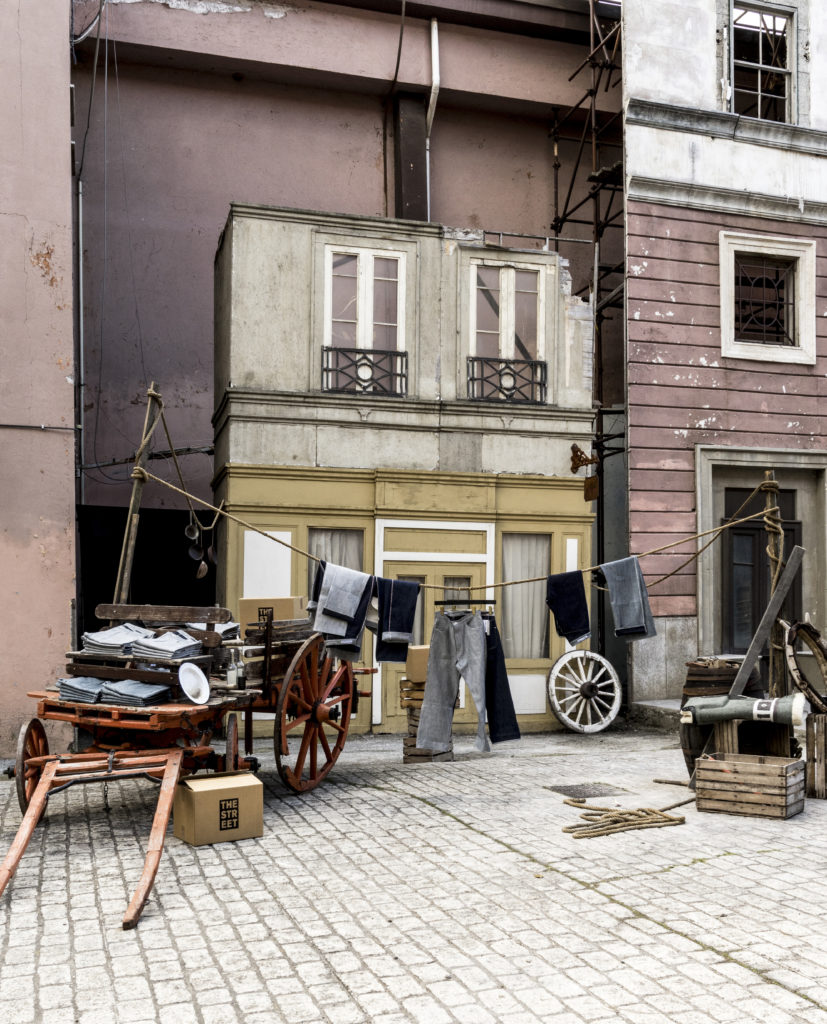
CM: Why did Tobias go to school in Hamburg as opposed to staying in Switzerland?
D: Well, you cannot have everything: one of the best art museums in the world, an amazing Kunsthalle, the art fair, and a good art school. At the time, art school in Basel sucked, and anyway, it is a small town. He wanted to get out. Plus, in Switzerland it is basically impossible to succeed as an artist; you need to first prove yourself elsewhere. It is ridiculous. Perhaps they sink you with prize money and grants but that does no good. CM: Rumor has it that Tobias snuck into Michael Krebber’s class at the Städelschule in Frankfurt…
Laura Dennis: In the 1990s, the contextual practices of artists in Cologne—the relational aesthetics practices, functioning more globally—and the NYC-based legacies of institutional critique, produced a generative dialogue for critical practice that echoed in the 2000s through the Lower East Side as well as at Städel. By 2009, could an artistic position still be formulated from Michael Krebber’s palate?
D: After three years in Hamburg with Jonathan Monk and Andreas Slominski, Tobias wanted something new. He attended the Canvas and Careers symposium at Städel and then invited one of the lectures to Hamburg to revisit his talk from the symposium. Egija Inzule (Tobias’ partner), lived in Leipzig from 2005 to 2009 and was close to artists such as Hans-Christian Lotz, Alexander Hempel, and Inka Meissner. They were just a few years older, but being a student, that mattered. Of course, whatever they did was key to Tobi. Hans-Christian Lotz went to Krebber and although Tobi never painted, he was very interested in his “refusal style.”
The school refused him as a guest student, so he simply moved to Frankfurt and just started going to Krebber’s class.
LD: In New York, in the Colin de Land era, social refusal amongst artists—e.g. the refusal to participate in all aspects of the art world, except which were deemed productive—was undergirded by a political sentiment that the art world was inherently toxic, and that the bulk of its energy was meant to be avoided at all costs. In as much, certain social spaces, museum relationships, and galleries became safe spaces to work. This “refusal style” in New York, developed concurrently with Krebber’s position in Cologne, is characterized by two aspects: one a critical rejection, and the other an overt sense of staging within and a “productive” context. How did this double aspect of refusal play out in Kaspar’s work?
D: I think it has all do to with the downfall of subculture; Michael Bracewell wrote a lot about it in When Surface Was Depth: Death by Cappuccino and Other Reflections on Music and Culture in the 1990s (2002). It discusses how US-based chains like Starbucks fundamentally changed consumer approaches, work spaces, and much more.
LD: In 2010, Tobias, Inzule, and Axel Wider curated a show entitled In the Middle of Affairs, which included artists from multiple generations, such as John Knight, Philippe Thomas, and Hans Christian Lotz, as well as key references to the critic and curator Ghislain Mollet-Viéville. From the outside, the show looks as though it was attempting to open up a new set of terms to be examined with critical thought, notably a continued focus on social space—highlighting lifestyle and also an interest in boundary crossing within culture, for example, transpositions between art and fashion. What were the goals of this project?
D: There was not a goal—the exhibition was interested in analyzing aesthetics of distribution by looking at an older institutional critique generation, and how the younger artists were possibly interested in their approaches.
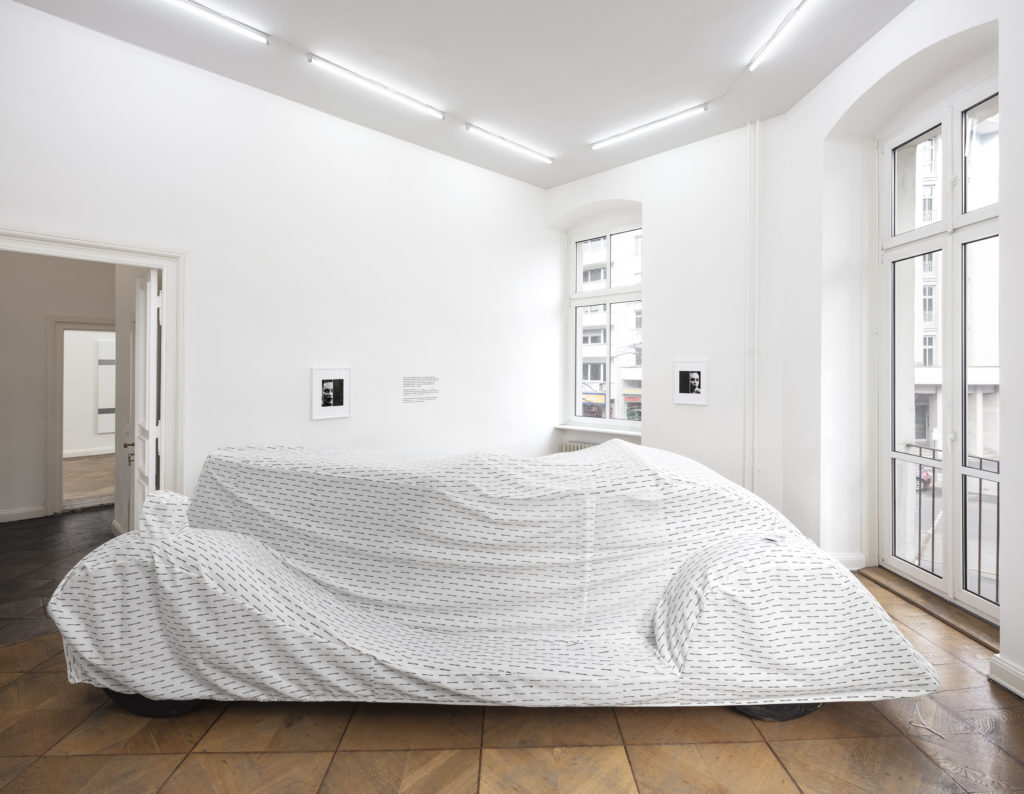
LD: In the work Bodies in the Backdrop, conceived for a solo exhibition in 2012 at Halle für Kunst and later shown in the Frozen Lakes exhibition at Artist’s Space, there is a “voice” in the works made manifest through the phrasing in the text below the images. The voice speaks of noticeably private aspects of the art process, such as the party for the artist or other less “public” moments in the process of showing. Is the private, or semi-private, sphere of relations within the field of art significant for you to discuss in the public, or semi-public, space of a gallery or not-for-profit space?
D: I am interested in how work and private life are not separable. In the work Bodies in the Backdrop, I used text fragments from Peggy Guggenheim’s autobiography. It is a total cliché of a book, completely worn out, in a way that using text fragments from this book was an attempt to squeeze out the last essence of something. In Peggy’s case, the book is pure gossip—discussing how love and friendship shaped her collection. At the time, I was living in Berlin and the social arena was a mess—a good one. Focusing on gossip instead of academic texts, making a work look like hard-core conceptual art, combining text and photo like Louise Lawler, and instead of supporting, questioning one another.
CM: Is lifestyle a proposition in Kaspar’s work?
D: You know, Alex Gartenfeld told me once that one can tell by communicating with Tobias that he grew up without the Internet— that email and social media started when he was a teenager, or even later. I guess we are the generation who knew the “before,” just not well enough to tell the difference from how it is today. On the other hand, all European aristocrats were at all times perfectly informed about one another. The only thing that had changed was the pace. The first Silberkuppe show was entitled Living Well is the Best Revenge (2010), a Gerald Murphy quote. So yes, life plays a matter and definitely influences style too.
CM: Whose voice speaks in the art of Tobias Kaspar?
D: One of many, or “Einer unter Euch,” to quote Kippenberger. Granted, Tobias has nothing to do with Kippenberger because of his disgraces, such masculinity and drinking behavior, no matter how much performed it was or is.
CM: Who does his work speak to?
D: USP? Universal Selling Point? If I only knew, then I could ask “them” directly. What I have noted is that the ones who buy his work, and others who seem to be deeply involved and touched by it, are not necessarily the same.
CM: Does Tobias collaborate? Does he not collaborate?
D: All of his work is somehow driven by collaborative forces—it has a lot do with the desire of being together, with choreographing a moment of people coming together. It has to do with exchange in various forms, and he tries to keep that somehow open, although at the end of the day it is Tobias Kaspar going out there claiming and signing things. Although he, Tobi, as a person has nothing to do with this “Tobias Kaspar” anymore.
CM: Do you think Tobias is a precarious worker?
D: If we look at the art fair and auction housed-based art world, yes. If we look at the world-at-large, he is uber-privileged.
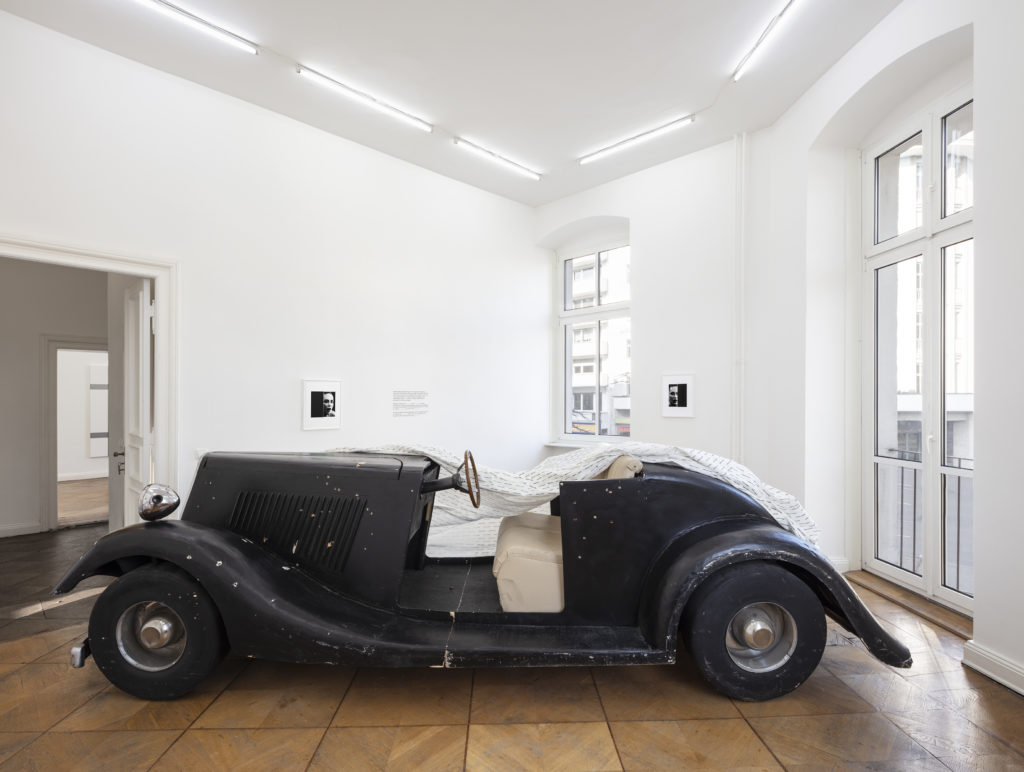
CM: Does Tobias like to hear gossip?
D: Do you? I assume everyone does. I find it interesting, in contrast to “official” communication which is so controlled and regulated. Gossip is somehow a gray space where right and wrong, truth and fiction, are blurred. Lately those categories have gotten a bit abused by right wing politics. I vote left. I do not believe in the bullshit of freedom of choice and freedom to vote. Can you believe we live in a world where individual states— or even worse, religions—tell people how to live together, to marry? The state offers a service to put people together. Soon, we may look at this as disgusted as some cultures look at arranged marriages. Why should the state dictate what a family is? We live in an insanely constructed and over regulated society which such extreme prejudgments.
CM: Do you think Tobias sees politics in different mediums or modes of communication?
D: I think every media requires a different communication/distribution channel, although Tobias Kaspar as a brand is mainly known in the arts. The jeans have slowly found their way into concept stores, and PROVENCE lives a life of its own.
CM: What is the role of performance in The Street?
D: The Street (2016) was a Truman show in arts. Everything was fiction, and this fiction slowly, over the course of twenty-four hours, became reality—so much so that a guest (one of the producers) vomited at the gallery opening dinner and people urinated behind houses that were actually just facades held by scaffolding. Earlier, people sat on the street, read newspaper in the cafe, someone made a flea-market— people treated this highly fictitious setup in a cinema studio street as a reality. Of course, certain characters, such as a group of teenagers hanging in front of brownstone, or a shop owner, or an angry person were cast to perform roles; but they were hard to expose, and instead carried the function of catalyzers or animators to stimulate the scenario.
CM: What is the role of documentation in The Street?
D: Since I wanted the street “to be” and not feel like a production place—contrasting with how studios are used to make films—I exhibited there and developed an ephemeral scenario which one could only experience in the here and now. During the set-up, the Italian television network RAI came to film The Street, but they were not allowed once guests arrived. I only have the material people posted on Instagram and by one single photographer, which we hired to photograph.
CM: How do the references to cinema in the Kunsthalle Bern show relate to the project as a whole?
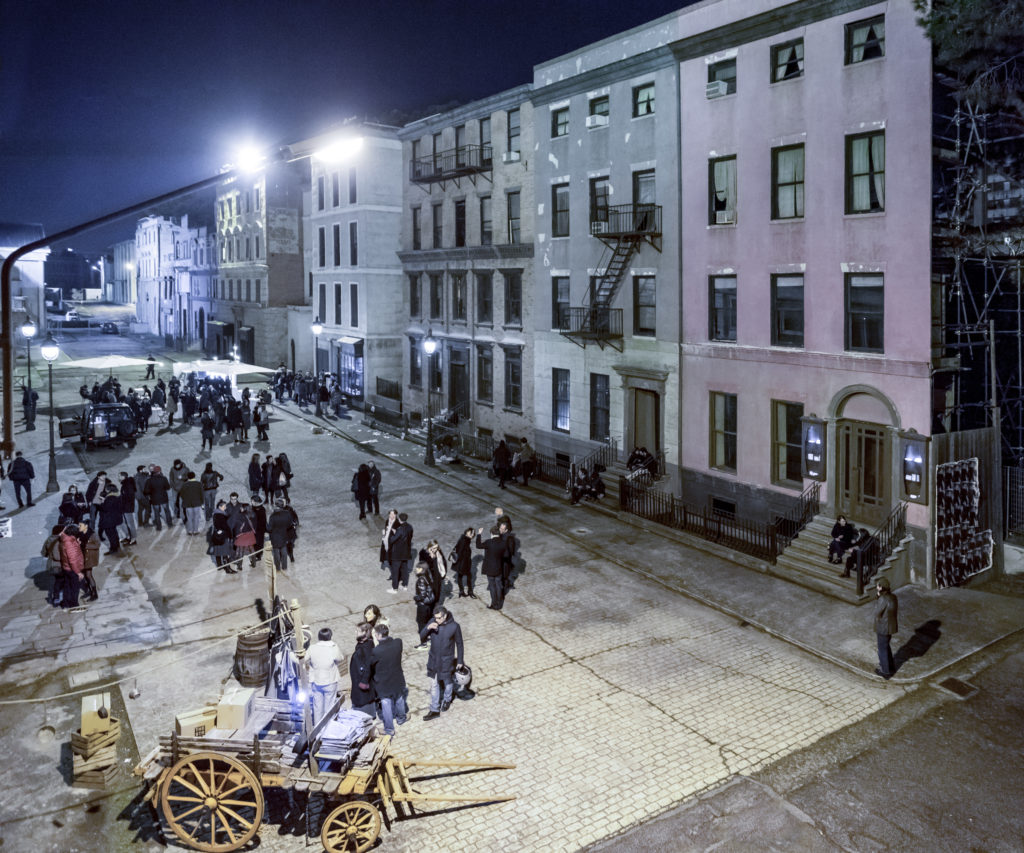
D: You probably would not believe it, but I grew up without TV, as a kid I had only seen one movie, The Lion King. Growing up in a post-hippy, anthroposophical, Beuys-influenced environment, where mass media did not exist for me until the age of fifteen, when I moved to Canada on an exchange program. When I was a teenager, I shopped in second hand and charity stores, and just then in the mid 90s, H&M and McDonalds arrived. In my whole life, I had never entered one. So, at age fifteen, I watched Hollywood films, and then when back in Copenhagen, moved out at the age of sixteen and in with Manuel Scheiwiller (Young Boy Dancing Group) into our first own apartment. After graduating from high school at age eighteen, I moved to Germany to study art and was near to the film classes of Marie Jose Burki, but also ‘real’ cinema people, such as Wim Wenders who also taught there.
How people deal with mainstream culture has obviously interested Tobias, as it is something he did not naturally grow up with but learned in retrospect as a teenager. In Bern, we used a discarded theater stage design from a local hobby group rendition of One Flew Over the Cookoo’s Nest a year before, and at Lars Friedrich we featured a theater prop car from Bonnie and Clyde in the exhibition. Both films are pre-1968—super heteronormative, but nevertheless struggle with society’s conformism.
To work with cinema or theater props is, for reasons of uncanniness, interesting— especially when built by hobbyists. Props are not sculptures; they are made to be filmed or photographed or viewed on a stage from a distance. You look at them through a filter (camera, distance) in opposition to sculpture which need to intrigue when standing in front of them.
CM: Is Tobias Kaspar a fictional character?
D: As much as we all are.